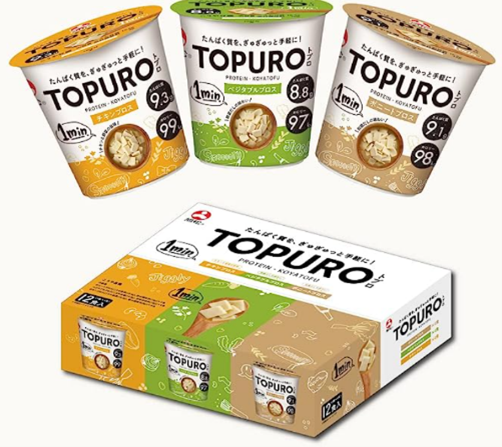Soy Food Innovators Address Food, Health and Flavor Trends
- Category:
- Soy Foods

The attributes of soy foods remain in sync with current food trends and the focus on sustainability. To further increase the demand for U.S. Soy, soybean growers and soy innovators actively work to meet the ever-evolving needs of global consumers. Today’s shoppers and restaurant-goers are expected to continue seeking affordable ways to have a healthy diet, and quick, convenient ways to prepare quality foods at home. They are also increasingly tuned into whether their food sources are healthful, sustainable and equitable, among other concerns.[1]
Keeping Pace with Dietary Evolution
Soy foods have much to offer. More than half of Americans report they have followed a specific eating pattern or diet in the past year, with high protein diets being the most popular.[2] Global flavors continue to intrigue consumers, with Asian and Mexican flavors being especially popular.[3] U.S. restaurant customers also seek out global ingredients, ranging from lesser-known fruits like yuzu to new takes on condiments like sriracha.[4] On-trend soy products include yuzu flavored tofu and sriracha flavored baked tofu.
On the food and health front, plant-based innovation is one of the 2023 trends, with a focus on sustainability. For example, plant-based pasta and snack products are expected to be on the rise.[5] The U.S. Soy Sustainability Assurance Protocol (USSAP) demonstrates the commitment of U.S. soybean growers. Soy foods provide many options for meeting consumer demands. Among plant proteins, soy is the only one comparable in quality to animal protein.[6] In addition to center-of-the-plate soy foods, low-sugar protein snacks like flavored roasted soy nuts appeal to snackers who want better-for-you choices.
Soy Offers Ingredient Options
Sugar and salt are among the ingredients that health-conscious consumers tend to be limiting in their diets. Front-of-package labeling regarding ingredients of concern is used in many countries. Nutrient profiling can be seen on labels in Europe, the UK, the U.S., Australia and New Zealand.[7] The World Health Organization (WHO) reports that consumers take in more than 4 mg of sodium daily, double the recommended amount. In the interest of reducing sodium intake to improve health and reduce noncommunicable diseases, 194 WHO member states committed to a 30% reduction in the population’s sodium intake by 2025.[8] Versatile soy foods such as tofu can help in this quest. On average, silken tofu contains zero grams of sugar and 15 mg of sodium per serving.
A Team Effort to Implement Soy Food Innovations
U.S. grown non-GM high oleic soybeans are now used by the Japanese food industry for new, on-trend products. For consumers, high oleic soybeans have an improved fat profile with the potential to offer heart health benefits. For the food industry, high oleic soybeans extend the shelf life of products and extend the fry life of oil.[9] High oleic soybeans contain greater than 70% oleic acid, the same percentage as found in olive oil, and nearly four times the amount found in regular soybeans.
New products launched in Japan during the first quarter of 2023 are a collaborative effort incorporating the non-GM high oleic soybeans. A Japanese manufacturer is working with a soybean importer, a U.S. soybean researcher/developer of identity preserved food grade crops and the Missouri Soybean Merchandising Council to bring the products to market. The soybean developer plans to increase a new yellow hilum high oleic soybean variety to help boost the available supply for the manufacturer.
The food company’s first product is an instant cup, ready-to-eat Kori-tofu, available for online purchase in Japan. The product uses both regular non-GM and a non-GM high oleic soybean variety. The product is promoted as having low salt, low sugar content (0.8 grams sugar per 100 grams) and is 51% protein. Kori-tofu—a dehydrated (freeze-dried) soybean curd— is a traditional ingredient in Japanese cooking. It is made by a process that extracts and condenses nutrients.[10]
Kori-tofu can also be used in baking. It recently made its debut in Europe in the form of bread, cereal and snack applications.[11] Soy foods, both traditional and innovative, are positioned to gather momentum as they evolve along with global consumer demands.
#
This article was (partially) funded by the United Soybean Board.
[1] Innova Market Insights. Top Ten Trends for 2023.
[2] International Food and Information Council. “2023 IFIC Food and Health Survey Shows Americans Feel the Impact of Rising Costs, Stress and Social Media on Food Choices.” Press release, May 23, 2023
[3] Nutritional Outlook. 2023 Flavor Trends for Food and Beverage, January 2023. https://www.nutritionaloutlook.com/view/2023-flavor-trends-for-food-and-beverage
[4] National Restaurant Association. What’s Hot Culinary Forecast 2023.
[5] International Food Information Council. “Food Trends for 2023 Will Include Wellness Drinks, Gut Health, Plant-Based Food Innovations, Confusion Around New Labels and Terminology,” Press release. January 4, 2023. https://ific.org/media-information/press-releases/food-trends-for-2023/
[6] UNITED SOYBEAN BOARD
[7] Kerry Health and Nutrition Institute. Ten Key Health and Nutrition Trends, 2023.
[8] WHO global report on sodium intake reduction. Geneva: World Health Organization; 2023.
[9] U.S. Soy. https://food.ussoy.org/food-industry-solutions/high-oleic-soybean-oil
[10] Takahiro Ishiguro and Hisashi Murasawa. “Kori-tofu Making Processes Increase High-Molecular-Weight Fraction (HMF).” Jpn Pharmacol Ther, vol.44, No.4, 2016.
[11] Nutrition Insight. “Japan’s Historic and Nutritious Kori-Tofu unveiled in Europe in Novel Cereal, Bread and Snack Applications.” December 2022.